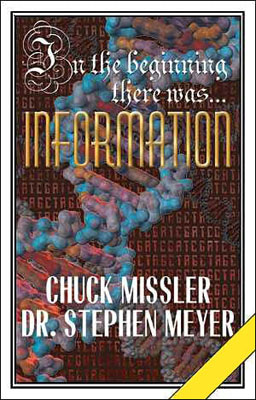The Myth of our Age
Jesus warned us, "Take heed that no man deceive you." 1 And we do, indeed, live in the Age of Deceit. Our entire society is totally driven by many myths, none more basic or insidious than the convictions of Evolution, the religion of our age. (Dismissing for this discussion the observations of microevolution, the variations within species, but rather using the term in its connotative sense, referring, in fact, to biogenesis: the notion that we are all the result of a series of cosmic accidents.)
The ancient cultures worshiped gods of wood and stone. It is difficult to comprehend the insanity of paganism: who can tally the blood that has been spilled on the altars of the gods who are not and the demons who are! We, however, in our contemporary paganism, have invented the most insulting "god" of all. Instead of ascribing the awesome magnificence of the Creation to any of the false gods of the past, we have chosen to ascribe it all to randomness, or chance. That has to be the most insulting ascription of all: we have decided that no Designer was necessary - it all "just happened." "First there was nothing. Then it exploded!"2
The premise that we are all simply the accidental result of random chance underlies our entire culture, not just biology: the fields of psychology, our social and political sciences, our media, our entertainments, and, of course, the forced inculcation of our children in the government schools.
But there is a glimmer of good news.
The Death of Darwinism
The good news is that there is a rising awareness that Evolution is bad science. Science purports to follow the evidence, relying on empirical verification for its conjectures. And it is increasingly evident that the evidence is mercilessly denying randomness as an explanation for the elegant designs embodied in the machinery of the universe. The writings of Denton, Behe, Johnson, Dempski, and Meyer have turned the thinking world upside down.3 The rebuttals have come from virtually every field of science: paleontology, physics and, quite conclusively, microbiology. Interestingly, perhaps the most compelling refutations come from one of the newest of the sciences: the information sciences, the field which has given us advanced communications and computers.
The Spectrum of the Possible
William Dempski has exquisitely profiled the spectrum of possibilities from certainty, "a probability of 1.0," to impossibility, "a probability of 0." (All events, by definition, lie between these two boundary conditions.) Figure 1 summarizes this spectrum:
When events are characterized by a high degree of certainty, we call them "scientific laws," such as gravity, etc. Most events, however, are characterized by some level of uncertainty, and the exploration of their likelihoods occupy the attention of statisticians, businessmen, and professional investigators dealing with the circumstances in the "real world."
When we encounter events that are extremely improbable - that is, highly unlikely to have occurred by unaided chance alone - we attribute them to deliberate design. If we walked into the kitchen and found a scattering of alphabet soup letters on the floor that spelled out a meaningful sentence, we would recognize that it was the deliberate handiwork of someone doing the spelling. Cryptography is also an example of exploring discoveries which are highly improbable to be attributed to chance as the rival conjecture.
If we encountered a series of ostensibly "random" letters, but discovered that some systematic transformation rendered them into a meaningful sentence, we would infer that someone had hidden that message there deliberately. Random chance would be deemed too unlikely to have caused that unaided.
The forensic debates in a courtroom also typically deal with rendering random chance as the unlikely contributor to the evidence which points to deliberate intent or design.
The discovery that our DNA codes are three-out-of-four, error-correcting codes, which are stored, retrieved, copied, and processed to instruct machines to fabricate the complex proteins that make up living organisms, has rendered any attribution to unaided chance as absurd in the extreme. (For those of our readers with advanced technical aptitudes, we strongly recommend the writings of William Dempski listed in the bibliography at the end of this article.)
Irreducible Complexity
Michael Behe has upset the comfort of the Darwinists by highlighting a design attribute that he terms "irreducible complexity." Consider, as an example, the familiar household mousetrap in figure 2.
This simple device consists of five essential parts: (1) a platform which holds (2) a hammer driven by (3) a spring when restrained by (4) a holding bar until released by (5) a catch. This basic design has defied attempts to simplify it further, or to reduce its complexity. The significant feature is that with only four of the five parts one cannot catch 4/5ths as many mice! Its function depends on each of its essential elements, each of which involve substantial precision in their specification. "Natural selection" cannot operate until there is something to select from.
Behe then presents an example of "irreducible complexity" from nature by reviewing the tiny motor that powers the flagellum, which propels a bacterium through the water:
Figure 3: This tiny mechanism, positioned to penetrate the bacterium's protective outer membrane, consists of over 40 parts - each of which are essential to its functioning. Figure 4 presents a functional equivalent: with any of its 40 parts missing, this mechanism would not be functional and would be a casualty in the processes of "natural selection" postulated by the Darwinists. The bacterium, dependent upon its locomotion, would be likewise.
So how did it come about? All the Darwinists can do is assert rather than explain.
The Miniature City
Darwinists love to postulate the "simple cell." With the advent of modern microbiology, we now know "there ain't any such thing." Even the simplest cell is complex beyond our imagining.
As Michael Denton has pointed out, "Although the tiniest bacterial cells are incredibly small, each is in effect a veritable microminiaturized factory containing thousands of exquisitely designed pieces of intricate molecular machinery, made up of 100,000,000,000 atoms, far more complicated than any machine built by man and absolutely without parallel in the nonliving world."4
The "simple cell" turns out to be a miniaturized city of unparalleled complexity and adaptive design, including automated assembly plants and processing units featuring robot machines (protein molecules with as many as 3,000 atoms each in three-dimensional configurations) manufacturing hundreds of thousands of specific types of products. The system design exploits artificial languages and decoding systems, memory banks for information storage, elegant control systems regulating the automated assembly of components, error correction techniques and proofreading devices for quality control.
All by chance? All without a Designer? (How do you define "absurd?")
When I was at the Ford Motor Company, one of our proudest assets was the famous River Rouge Plant in Dearborn. It was the largest totally integrated manufacturing facility in the world. With 97 miles of railroad within the plant, raw iron ore and limestone entered one end; the necessary steel, glass, and paint were manufactured within the facility. The entire cars (including the engines on automated lines) were fabricated within the plant, and new Mustangs came out the other end. Yet this entire complex pales in comparison to the elegant high order of design demonstrated in the simplest cell, which can also replicate itself in a matter of hours.
The Darwinian Bankruptcy
An elegant design is more than the parts themselves: it involves information. It requires information input external to the design itself - and the deliberate involvement of a Designer.
The Darwinians cannot explain the origin of life because they cannot account for the origin of information. The technology that provides language - semantics and syntax, for example - is quite distinct from the technology of the ink and paper it may be written on. The physical features of the circuits in a computer provide no clue about the design of the software that resides within it. It is profoundly significant that the Title of the Creator is the Logos - The Word:
In the beginning was the Word, and the Word was with God, and the Word was God. The same was in the beginning with God. All things were made by him; and without him was not any thing made that was made.
John 1:1-3
This article was excerpted from our featured Briefing Package, In the Beginning There Was...Information.
Notes:
- Matthew 24:4, 24.
- John Loeffler's classic summary of the Big Bang.
- See the sources listed above.
- From Evolution: A Theory in Crisis, Adler & Adler, Bethesda MD, 1986.
Sources:
- Michael Denton, Evolution: A Theory in Crisis, Adler & Adler, Bethesda MD, 1986.
- Michael J. Behe, Darwin's Black Box, Simon and Schuster, New York NY, 1996.
- Philip Johnson, Darwin on Trial, Regnery Gateway, Washington D.C., 1991.
- William Dempski, The Design Inference, Cambridge University Press, Cambridge UK, 1998.
- Dr. Stephen Meyer, various articles; see also In the Beginning There Was... Information.
- Perloff, Tornado in a Junkyard, Refuge Books, Arlington MA, 1999.
- Werner Gitt, In the Beginning Was Information, Christliche Literatur-Verbreitung e.V., Postfach Bielefeld, Germany, 1997. (Trans. of Am Anfang war die Information, Hnssler, Neuhausen-Stuttgart, Germany 1994.)







